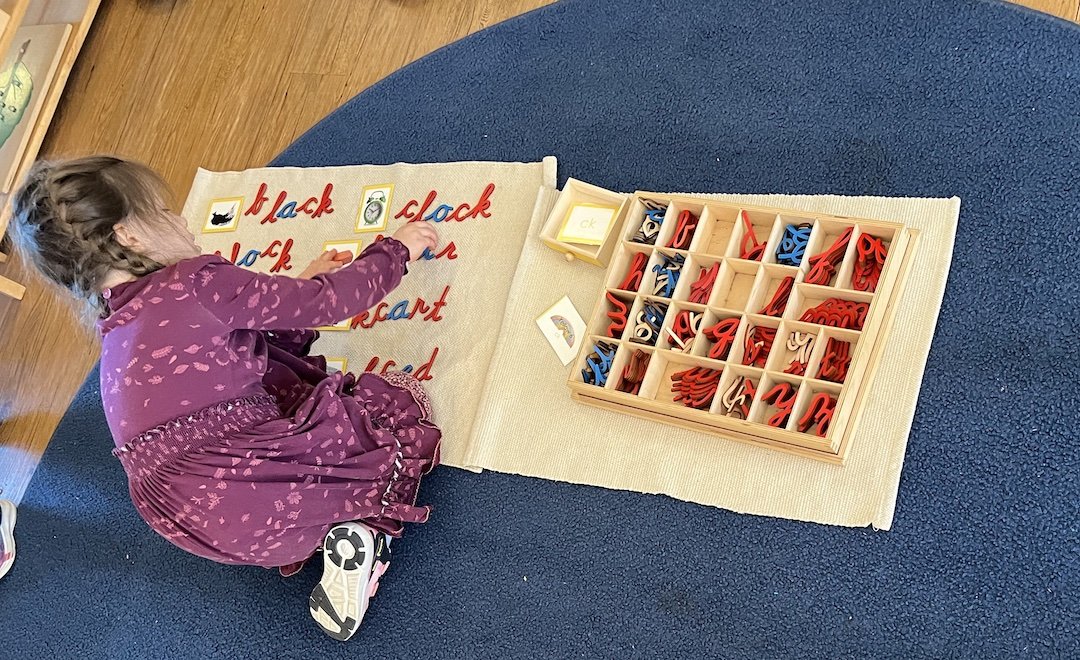Primary
3 to 6 years
Order, concentration, coordination, and independence
The Prepared Environment
We refer to our Montessori classrooms as a “prepared environment.” This name reflects the care and attention given to creating a learning environment that reinforces the children’s independence, creativity, imagination, and intellectual development.
Montessori classrooms tend to fascinate children and their families. They are bright, warm, and inviting, filled with plants, animals, art, music, and books. They are equipped with intriguing learning materials, mathematical models, maps, charts, artifacts, scientific materials, a natural science center, music, and art. Food preparation and flower arranging invite collaboration.
In her book, The Montessori Method, Dr. Montessori describes the transformation that takes place during the first few months of school as the children evolve into a “family.” They prepared and served the daily meals, washed the pots and dishes, helped the younger children bathe and change their clothes, swept, cleaned, and worked in the garden. These very young children developed a sense of maturity and connectedness that helped them realize a much higher level of their potential as human beings.
Our Primary classrooms are peaceful, beautiful, and orderly learning environments. Montessori encourages children to learn from each other. The multi-age environment gives children the opportunity to learn from others. Children are given lessons individually or in small groups and encouraged to explore carefully selected and sequenced materials to cultivate independence and concentration. The classroom and school communities tend to be rather stable, with just the oldest third moving on to the next level each year. With children growing together over many years, close relationships develop among the children and adults.

The Children’s House
This is the children’s community. They move freely within it, selecting work that captures their interest rather than participating in all-day lessons and projects selected by the teachers. In a genuine sense, even young children are responsible for the care of their own child-sized environments. When they are hungry, they prepare their own snack and drink. They go to the bathroom without assistance. When something spills, they help each other carefully clean things up.
Since the first Children’s House opened in 1907, parents have been amazed to see small children in Montessori classrooms cut raw fruits and vegetables, sweep and dust, carry pitchers of water, and pour liquids with barely a drop spilled.
The children normally go about their work so calmly and purposely that it is clear to even the casual observer that they are the masters in this environment: a “Children’s House.” In the Children’s House, children develop good work habits and a sense of responsibility for their work and the environment. The goal is for children to learn how to take care of themselves, others, and the world around them.
Our Montessori Guides are trained observers, carefully presenting activities to develop language, reading, math, music, art, practical life, and science skills when the child is developmentally ready.
They interact positively with the children and are models of kindness and respect. Each child is treated as a unique individual. They progress through the extensive and challenging Primary curriculum at an individual pace. Children receive individual presentations of new work and are then able to practice the work as much as necessary to achieve mastery.
It may take a moment to spot the teachers within the environment. They will normally be found working with one or two children at a time, advising, presenting a new lesson, or quietly observing the class at work.
While academic excellence is an important goal, Primary classrooms also focus on the children's social, emotional, and physical development to help them develop kindness, confidence, responsibility, curiosity, creativity, and self-direction.
Children explore materials across five curriculum areas:
Practical Life
Practical Life is the foundation of the Montessori Primary classroom. All of the Practical Life activities build gross and fine motor skills while helping children develop concentration, order, independence, and coordination. Practical Life work includes care of the self, care of the classroom environment, food preparation, and wonderful grace and courtesy lessons.
Sensorial
The beautiful Sensorial materials were developed by Maria Montessori to refine the senses since all information enters our brains through our five senses. This area includes dimensional materials such as the Pink Tower and Red Rods as well as materials for refining touch, taste, smell, sight, and hearing. The Sensorial materials also develop order, concentration, and both gross and fine motor skills and are excellent preparation for academics.
Mathematics
Montessori math is a hands-on, concrete approach to learning about mathematical concepts. Students can experience math in a multi-sensory manner, which helps them to develop a mental framework for learning abstract math concepts. Instead of rote memorization, children develop understanding. Teachers present small concepts separately and sequentially, building on the child’s mastery. Some examples are Sandpaper Numerals, Spindle Box, and Golden Beads.
Language
Oral language, reading, and writing skills are developed in this area. Through the use of multi-sensory materials, children progress from learning sounds to reading books, from writing letters to writing stories. The language area promotes a love of reading and writing.
Geography & Science
Children explore science and geography with a wide range of materials, learning an extensive vocabulary and widening their understanding of the world around them. Geography materials include the puzzle maps and the land and water forms, as well as a wide range of materials for the study of each continent. Science materials include the solar system, magnetism, plant and animal studies, and a focus on the human body.







